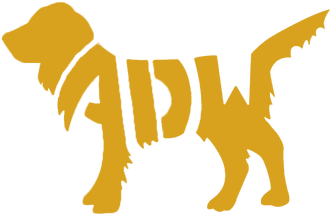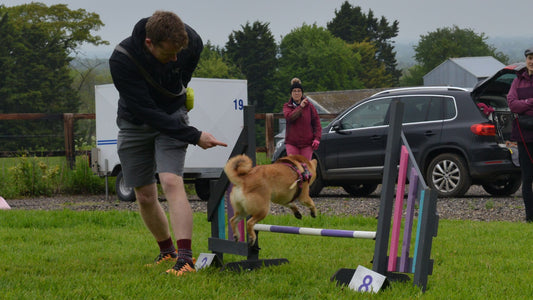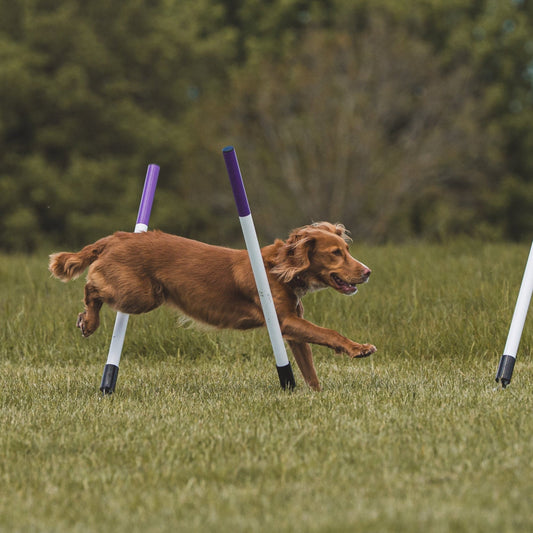In week 2 we build on the introduction of jumps and tunnels from the first session and add in the challenge of turns.
- Dogs are taught how to go left or right on cue because with dogs as fast as our attendees, steering is certainly needed!
- In agility, obstacles can be 5-10m apart, so it’s so powerful when you can get in a central position having taught your dog to navigate a circle remotely like a satellite!! So, we add in distance between you and your dog gradually to build independence.
- PLUS, where in week 1, your dog could see all the way through a straight tunnel, this week we progressively curving it, building your dog’s confidence to run through on command, despite not being able to see the exit.
- We conclude by bringing the skills together as a group by running a short sequence.
How week 2’s session works:
Fan work is where four jumps are arranged in a circle. The handler stands in the centre and with the arm closest to the dog out, they guide the dog around the fan.
According to Kennel Club Agility Rules obstacles are 5-10m apart; this means that on a course the fan can be quite a large circle that can require advanced handling and skill.
So, in our dog agility classes for beginners, we break this skill down into smaller steps. This sets the dogs up to succeed. Helping them rehearse success means they're more likely to succeed as we advance the difficulty of the exercises.
In dog training, there's a principle called “The 3-D’s” which means we can progress exercises by changing distance, duration, and distraction.
In our agility classes near Cambridge, it is our training approach to start with low distraction: just jump wings arranged in a small circle, no poles. As the agility course for beginners progresses, we gradually increase the size of the circle (distance). Then, finally, add in poles to make jumps part of the sequence (distraction).
How to practice dog agility at home:
You can build on the fan work foundations at home. Where in class we use jumps and wings, you can use almost anything! For example, posts in the ground, 4 chairs etc
TIP: if using posts, angle the poles inwards towards you, this will encourage the dog to go around the outside as it will be difficult for them to duck underneath to take the inside line!
Task 1:
First, you teach your dog to follow your outstretched arm holding a lure, guiding them around a complete circle. Plus, that circling loosely left or right outside of an obstacle rather than coming in next to you is what earns them a reward
- Stand in the middle of the circle of obstacles
- Hold a reward in the hand closest to your dog and use it as a lure to guide your dog; the reward can be a piece of a high-value food like chicken held between your finger and thumb, or a toy balled up in your hand.
- Guide your dog around ¼ of the circle, say ‘good’ when you complete the turn and reward by giving them the food or toy. With each success, lure them a bit further before saying ‘good’ and rewarding.
- Keep practising until the dog can complete a full circle before getting a food reward.
- Repeat on the other side so that you have practised moving clockwise and anticlockwise.
Goal to achieve: Practice until your dog can complete a full circle in both directions following a food or toy lure.
As demonstrated by Yogi in the short clip below 👇

Task 2:
This time, the hand closest to the dog (this is called your driving arm) will be held out empty and used to guide the dog around a complete circle 1 – 5m wide set out by posts or jump wings. This exercise teaches the dogs to follow an outstretched arm, circling loosely left or right, and that doing so earns them a reward. But this time they are following you, not a lure which makes it easier to build distance and independence from you.
Repeat steps 1-6 in Task 1. But instead of holding a reward in one hand and using it as a lure to guide your dog as you did previously in Step 2, this time you will hold out an empty hand.
Move your empty hand in the same way as you did in Task 1 to direct the dog around the circle.
You will reward by giving your dog a treat from your pouch or a game with a toy that was held behind your back after the rep.
Plus, say 'left' or 'right' while your dog is circling so they start to learn their verbal cue.
Change the difficulty level?
Make the exercise easier:
- Move the poles closer in so it is a smaller circle.
Make the exercise harder:
- Make the circle of posts larger (up to 5m between obstacles in line with the Kennel Club minimum distance rules.) Source: https://www.thekennelclub.org.uk/events-and-activities/agility/new-to-agility/agility-course-obstacles/
- Use jump wings (no poles) or a variety of other obstacles instead of posts.
Goal to achieve: Practice until your dog can complete a full circle in both directions following an empty hand to develop their 'Fan work' foundations. Start and finish at different places on the fan to vary where the reward will be delivered.
About the author:
Hi 👋 I’m Emma, accredited as a professional dog trainer by the Institute of Modern Dog Trainers (IMDT). I help owners of energetic dogs achieve the dog-owning life they envisioned by providing robust obedience & agility training for dogs in Balsham, near Cambridge.
Disclaimer: The content of this article does not include personalised advice and is for information purposes only. If you need individual advice or other enquiries please click here to get in contact or if you're not local to Anglian Dog Works, you can find a trainer in your area by going to the IMDT website: https://www.imdt.uk.com/find-a-qualified-imdt-trainer
Please share your questions and progress:
We would love to see how you get on with your dog’s introduction to place boards. For tips from our trainer and to share success post your pictures and videos in the Anglian Dog Works Facebook group. https://www.facebook.com/angliandogworks



